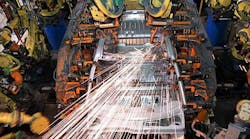While the last two decades have been trying for the manufacturing sector, large U.S. firms have been successful in figuring out how to make things work. They have outperformed their global counterparts, according to a new survey, Making it in America: Revitalizing US manufacturing, by The McKinsey Global Institute.
It’s a different story for the smaller companies supplying the larger one. These tier-two and -three suppliers haven't been able to see their domestic growth match their larger counterparts.
“The hollowing out of the supplier base now leaves larger manufacturers vulnerable to global supply chain risk and lacking a healthy domestic ecosystem that could provide resilience and opportunities for innovation,” says Katy George, report coauthor and managing partner at McKinsey.
“More broadly, the decline of manufacturing has diminished prospects for the U.S middle class. Our analysis finds that it contributed two-thirds of the recent fall in labor’s share of U.S. GDP.”
However, the study cites opportunities to turn things around.
“Demand is rising both at home and abroad—and there is enormous room to grow exports since less than 1% of U.S. firms sell into international markets, a far lower share than in any other large advanced economy,” says Sree Ramaswamy, a partner at the McKinsey Global Institute.
“Value chains are evolving to U.S. advantage, particularly for firms in advanced industries and their suppliers,” Ramaswamy added. “New business models are becoming possible as value shifts from production to R&D, design, and services. Favorable changes in relative labor and energy costs provide a tailwind.”
In order to capitalize on this growing demand, manufacturers will need to produce a wider range of product models with differing features, price points, and marketing approaches. In addition, companies will have to meet customers expectation of both more choice and customization. If U.S .firms are adept at figuring out what resonates with consumers and handling greater complexity, they can bring a bigger product portfolio to market profitably, the report predicts.
Technology Basis for Future Growth
Industry 4.0 will be essential to accommodate the growth. These technologies can provide the key to ramping up productivity growth and agility. New design tools can improve speed to market, creating rapid prototypes and simulations to validate processes before build-out. Internet of things sensors can combine with analytics and advanced robots to run flexible, autonomous factory operations.
Digital threads can connect firms with suppliers and customers, improving coordination and revealing data-driven insights that could lead to new sources of revenue. These technologies can help turn around slowing productivity growth in the overall sector and help manufacturing firms that have already maximized what they can do with cost-cutting approaches.
Future Scenario
McKinsey used these technology trends to outline scenarios for the sector’s future through 2025, combining projections for demand growth with industry-by-industry analysis that considers the probability and potential impact of technology adoption, export growth, favorable input costs, and a higher share of domestic content in finished goods.
It compares a baseline scenario of continuing decline to a “stretch” scenario in which the United States maximizes the available opportunities. In the optimal case, U.S. manufacturing GDP would climb to $3 trillion in real terms by 2025—a boost of some $530 billion, or 20%, above the current trend.
The biggest upside potential is found in the advanced manufacturing industries where the U.S. should have a competitive advantage but currently runs a large trade deficit.
“Capturing these opportunities will not be easy,” says Ramaswamy. “The manufacturing sector needs new capabilities and investment, and more firms need to participate in exports in order to bring the benefits of global trade to more US workers. Aging plants and equipment, especially in the supply chains of advanced industries, will have to be upgraded for digital readiness. The sector needs new digital and technical skills from its workforce, and U.S.-based manufacturers need to be as attractive to high-caliber talent as their foreign competitors.”
The study adds that turning around two decades of negative trend lines will take coordinated action and long-term investment on a much bigger scale.
It estimates that a national apprenticeship program serving 1 million workers could cost $40 billion annually while upgrading the sector’s capital base would take an additional $115 billion annually over the next decade.
The report also emphasizes the importance of both public- and private-sector efforts to revitalize struggling small and mid-sized manufacturing firms by improving their access to capital, technologies, and networking opportunities. Today the productivity gap between large and small firms is as high as 40%.
Building a stronger ecosystem of innovative, digital-ready small and midsize manufacturers would give the entire sector a shot in the arm.
“Revitalizing the entire sector will require dramatically scaling up what works—and the task is too big for any single entity,” says Katy George. “Manufacturing needs supportive government programs and policies with long-term certainty and funding. It also needs regional coalitions with everyone at the table: large and small manufacturers, workers, technology experts, educators, public officials, and investors.



